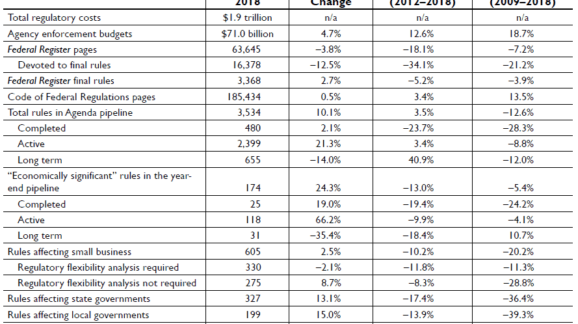Toward a Federal “Regulatory Budget”
Ten Thousand Commandments 2019 - Chapter 3

Download Chapter 3 as a PDF
When Congress spends, disclosure is necessary for voters to hold representatives accountable. Federal programs are funded either by raising taxes or by borrowing against a promise to repay with interest from future tax collections. Taxpayers can observe those decisions to some degree during the authorization and appropriations processes. They can inspect the costs of programs and agencies in Congressional Budget Office publications[i] and the federal budget’s historical tables.[ii]
However, Congress often “funds” objectives and programs through regulatory mandates. Regulation and spending are related; both are mechanisms by which governments act or compel individuals. Rather than taxing and paying directly, federal regulation can compel the private sector, as well as state and local governments, to bear the costs of federal initiatives. Regulation in such instances functions like an off-budget form of taxation and spending. Although disclosure of spending does not stop deficits, it is still vital to making progress toward that goal. Policy makers should disclose regulatory costs to the extent possible so that the choice to regulate can at least have an opportunity to get the full consideration it deserves.
Because the costs and economic effects of regulatory compliance are not budgeted and disclosed the way that federal spending is, regulatory initiatives can commandeer private sector resources with comparatively little public controversy. Policy makers may find it easier to impose regulatory costs than to embark on government spending because of the former’s lack of disclosure and accountability. And when regulatory compliance costs prove burdensome, Congress can escape accountability by blaming an agency for issuing an unpopular rule. Table 1 provides an overview of the federal regulatory enterprise in 2019.